
A Comprehensive Guide to Term Insurance
Term insurance is a popular choice for many individuals looking to secure their family's financial future without the higher premiums associated with other types of life insurance. This guide will delve into the intricacies of term insurance, helping you understand its benefits, features, and how to choose the best term insurance policy for your needs.n
Uploaded on | 0 Views
Download Presentation
Please find below an Image/Link to download the presentation.
The content on the website is provided AS IS for your information and personal use only. It may not be sold, licensed, or shared on other websites without obtaining consent from the author. Download presentation by click this link. If you encounter any issues during the download, it is possible that the publisher has removed the file from their server.
Presentation Transcript
A Comprehensive Guide to Term Insurance Term insurance is a popular choice for many individuals looking to secure their family's financial future without the higher premiums associated with other types of life insurance. This guide will delve into the intricacies of term insurance, helping you understand its benefits, features, and how to choose the best term insurance policy for your needs. What is Term Insurance? Term insurance is a type of life insurance policy that provides coverage for a specific period, or "term." If the insured person passes away during this term, the beneficiaries receive a death benefit. Unlike whole or universal life insurance, term insurance does not have a cash value component and is purely focused on providing death benefit protection. Key Features of Term Insurance 1. Fixed Coverage Period Term insurance policies are designed to last for a predetermined number of years, such as 10, 20, or 30 years. The policyholder selects the term length based on their needs and financial goals. 2. Affordable Premiums One of the main advantages of term insurance is its affordability. Premiums are typically lower compared to permanent life insurance because the policy does not accumulate cash value and only provides death benefit protection.
3. Level Premiums Many term insurance policies offer level premiums, meaning the premium amount remains the same throughout the term of the policy. This makes budgeting easier and provides financial predictability. 4. Death Benefit The death benefit is the amount paid to the beneficiaries if the insured person dies during the term of the policy. The policyholder determines the death benefit amount when purchasing the policy, based on their financial needs and objectives. 5. Convertibility Some term insurance policies offer a convertibility feature, allowing the policyholder to convert the term policy into a permanent life insurance policy without undergoing a new medical examination. This can be beneficial if the policyholder's needs change over time. Types of Term Insurance There are several variations of term insurance, each designed to meet different needs: 1. Level Term Insurance Level term insurance provides a fixed death benefit and fixed premiums for the entire term of the policy. This is the most straightforward and commonly purchased type of term insurance. 2. Decreasing Term Insurance Decreasing term insurance features a death benefit that decreases over time, usually in conjunction with a mortgage or other debt that decreases as it is paid off. Premiums often remain level, but the payout reduces each year.
3. Renewable Term Insurance Renewable term insurance allows the policyholder to renew the policy at the end of the term without a medical exam. Premiums may increase upon renewal, reflecting the insured's age at that time. 4. Return of Premium (ROP) Term Insurance ROP term insurance refunds the premiums paid if the policyholder outlives the term of the policy. While premiums for ROP policies are higher, they offer the benefit of a potential return on investment. Benefits of Term Insurance 1. Financial Protection Term insurance provides financial protection to your beneficiaries, ensuring they are taken care of in the event of your untimely death. This can help cover expenses such as mortgage payments, education costs, and daily living expenses. 2. Flexibility With various term lengths and coverage amounts available, term insurance offers flexibility to tailor the policy to your specific needs and financial situation. 3. Simplicity Term insurance policies are straightforward and easy to understand. There are no complex investment components or cash value accumulations to worry about.
4. Cost-Effective Term insurance is typically the most affordable type of life insurance, making it accessible for many individuals who need substantial coverage without high premiums. Factors to Consider When Choosing Term Insurance 1. Coverage Amount Determine how much coverage you need based on your financial obligations, such as debts, living expenses, and future financial goals for your beneficiaries. 2. Term Length Choose a term length that aligns with your financial responsibilities. Common term lengths are 10, 20, or 30 years, but some insurers offer other options. 3. Premiums Consider your budget when selecting a policy. While level premiums provide predictability, some policies may offer lower initial premiums that increase over time. 4. Insurance Provider Select a reputable insurance company with strong financial ratings and a good customer service track record. This ensures reliability and ease of claims processing. 5. Policy Features Evaluate additional features such as convertibility options, renewal provisions, and riders that can enhance the policy's value and flexibility.
Steps to Purchase Term Insurance 1. Assess Your Needs Calculate your financial obligations and future goals to determine the appropriate coverage amount and term length. 2. Compare Quotes Obtain quotes from multiple insurance providers to compare premiums, coverage options, and policy features. 3. Choose a Policy Select the term insurance policy that best meets your needs and budget. Ensure you understand the terms and conditions before finalizing your choice. 4. Undergo Medical Examination Complete the required medical examination, if necessary, to provide the insurer with information about your health status. 5. Review and Sign the Policy Once approved, review the policy documents carefully. Sign the policy and pay the first premium to activate your coverage. Conclusion Term insurance is a practical and affordable way to provide financial security for your loved ones. By understanding the different types of term insurance and the factors to consider when choosing a policy, you can make an informed decision that meets your needs and ensures peace of mind.
















































